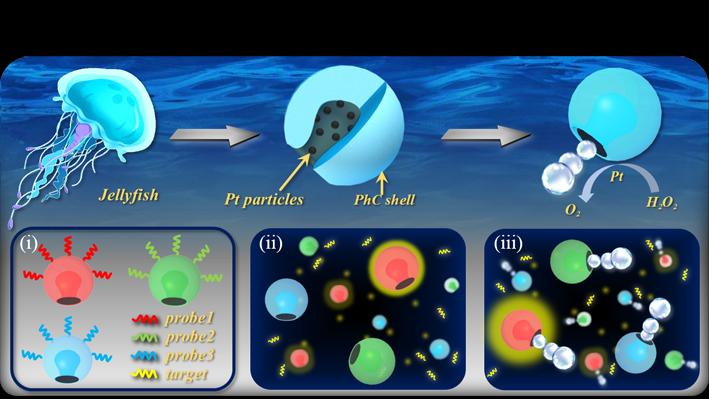Jan 17 2020
Micromotors are defined as artificial microscale devices that convert externally provided energy or supplied fuels into kinetic energy, to achieve autonomous movement.
 Scheme of the design of the jellyfish-liked structural color barcode micromotors and their application in biosensing. Image Credit: ©Science China Press.
Scheme of the design of the jellyfish-liked structural color barcode micromotors and their application in biosensing. Image Credit: ©Science China Press.
From the time the idea of micromotors was put forward, it has attracted immense scientific interest. Consequently, remarkable advancement has been achieved in leveraging different types of micromotors.
Significant attempts have shown that micromotors are highly valuable in the fields of environmental science, biomedical engineering, etc. Specifically, the application of micromotors in biosensing has gained considerable interest.
In contrast to conventional techniques, these micromotors-based approaches can significantly improve the sensitivity and considerably reduce the assay time of biomolecules. This is because the continuous movement of micromotors can enhance the possibility of target-receptor contacts.
Despite several advances made in this aspect, the latest micromotors used in biosensors can only perform single target screening and lack the ability to fulfill the needs of high-throughput and multiplex analyses, which is generally required to guide diagnosis. Hence, functional micromotors with multiplexing potentials are still needed in the biomedical field.
In a new study reported in National Science Review, researchers from Southeast University have described an innovative type of micromotors that exhibit stable structural color for multiplex assays. The researchers formed particles of colloidal crystal clusters that had stomatocyte morphology by using fast extracting solvent and assembling monodispersed nanoparticles into droplets.
In addition to exhibiting brilliant structural colors and typical reflection peaks owing to their ordered nanoparticles arrangement, the stomatocyte particles also offer effective cavities for integrating functional elements.
Thus, the researchers were able to achieve barcode micromotors with magnetic or catalyst elements in their cavities, and also with corresponding structural color coding, by making use of the ferric oxide (Fe3O4) and platinum (Pt) dispersed hydrogel to fill and duplicate the stomatocyte colloidal crystal particles.
Upon exposing the micromotors to a solution containing hydrogen peroxide (H2O2) additive, the Pt-dispersed hydrogel in their cavities was able to propel the micromotors by releasing catalytic bubbles, while the existing Fe3O4 could impart magnetic guidance for the micromotors.
The researchers showed that through their self-movement, these structural color barcode micromotors were able to efficiently increase the mixing speed of the detection sample and considerably increase the probe-target interactions toward more sensitive and faster detection. Moreover, the barcode micromotors’ magnetism enables the flexible collection of the micromotors, thereby facilitating the detection processes.
On the basis of the particular identification characteristic of the stable structural color coding, the barcode micromotors could also exhibit an unrivaled simultaneous multiplexing potential for DNA detection. From these results, it can be seen that the structural color barcode micromotors will offer an optimal platform for ultrasensitive multiplex assays in various fields.
This study was funded by the National Natural Science Foundation of China (grants 51522302 and 21473029) and the NSAF Foundation of China (grant U1530260).